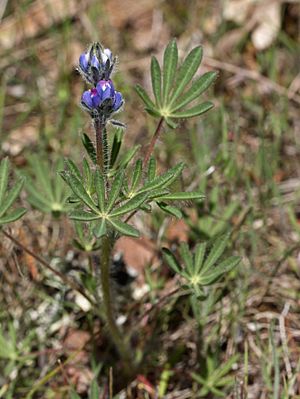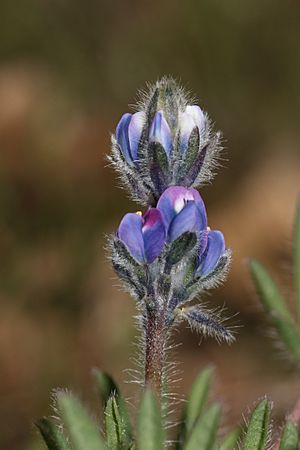Lupinus bicolor facts for kids
Quick facts for kids Lupinus bicolor |
|
|---|---|
 |
|
| Scientific classification | |
| Genus: |
Lupinus
|
| Species: |
bicolor
|
The miniature lupine (Lupinus bicolor) is a beautiful wild flower. It's also called Lindley's annual lupine or bicolor lupine. This plant is a type of lupine.
It grows naturally in western North America. You can find it from northern Baja California up through California and into British Columbia. It likes many different places, like grasslands, forests, and coastal areas. It often grows alongside other bright spring flowers, such as the California poppy.
What it Looks Like
The miniature lupine has a short stem covered in tiny hairs. Its leaves look like a hand with several fingers spread out.
The Flowers
The flowers grow on a stalk that can be up to 8 centimeters (about 3 inches) tall. As its name bicolor suggests, the flowers usually have two colors. One color is often a deep blue. The other color is usually white, but sometimes it can be light purple or pink. You might also see small spots on the petals.
Seeds and Pods
After the flowers bloom, the plant grows small, hairy pods. These pods are only a couple of centimeters long and are very thin. Inside, they hold tiny brownish seeds that look like peas.
Where it Grows and Why it's Important
This plant is grown in gardens because it's so pretty. People plant it in native plant gardens, drought-friendly gardens, and wildlife gardens. It's also used to help bring back natural areas.
The miniature lupine is very important for pollinators. These are animals that help plants make seeds. Native bees and bumblebees love this plant. For example, in Santa Barbara, California, planting miniature lupine helped increase the number of native yellow-faced bumblebees.


